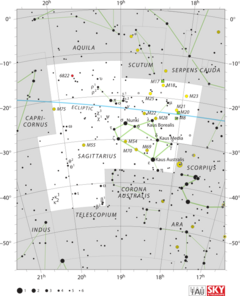Astronomy:Kappa2 Sagittarii
| Observation data Equinox J2000.0]] (ICRS) | |
|---|---|
| Constellation | Sagittarius |
| Right ascension | 20h 23m 53.17666s[1] |
| Declination | −42° 25′ 22.3376″[1] |
| Apparent magnitude (V) | +5.64[2] (6.04 + 7.12)[3] |
| Characteristics | |
| Spectral type | A5 V[4] (A1 + A6)[5] |
| U−B color index | +0.099[2] |
| B−V color index | +0.192[2] |
| Astrometry | |
| Radial velocity (Rv) | +2.6[6] km/s |
| Proper motion (μ) | RA: −13.07[1] mas/yr Dec.: +13.64[1] mas/yr |
| Parallax (π) | 10.47 ± 0.50[1] mas |
| Distance | 310 ± 10 ly (96 ± 5 pc) |
| Absolute magnitude (MV) | 1.03/2.35[5] |
| Orbit[7] | |
| Period (P) | 700 yr |
| Semi-major axis (a) | 2.032″ |
| Eccentricity (e) | 0.401 |
| Inclination (i) | 80° |
| Longitude of the node (Ω) | 40.7° |
| Periastron epoch (T) | 1912.00 |
| Argument of periastron (ω) (secondary) | 177.3° |
| Details | |
| κ2 Sgr A | |
| Mass | 1.85[8] M☉ |
| Luminosity | 38[9] L☉ |
| Surface gravity (log g) | 4.03[8] cgs |
| Temperature | 7,990±272[8] K |
| Age | 833[8] Myr |
| Other designations | |
| Database references | |
| SIMBAD | data |
Kappa2 Sagittarii (κ2 Sagittarii) is a binary star[3] system in the zodiac constellation of Sagittarius. It is visible to the naked eye with a combined apparent visual magnitude of +5.64.[2] Based upon an annual parallax shift of 10.47 mas as seen from Earth,[1] this system is located around 310 light years from the Sun. They are receding with a radial velocity of +2.6 km/s.[6]
This is a visual binary system with the components orbiting each other over a period of roughly 700 years, having an eccentricity of 0.4 and a semimajor axis of 2 arc seconds.[7] The pair have a combined spectral type that matches an A-type main sequence star with a stellar classification of A5 V.[4] The individual components are of estimated types A1 and A6.[5] The primary member, component A, is a magnitude 6.04[3] star with 1.85[8] times the mass of the Sun. It is radiating 38[9] times the Sun's luminosity from its photosphere at an effective temperature of about 7,990 K.[8] The companion, component B, is visual magnitude 7.12.[3]
There are two visual companions: component C is a magnitude 14.3 star at an angular separation of 18.6 arc seconds along a position angle of 266°, as of 2000; component D is magnitude 14.0 with a separation of 29.8 arc seconds along a position angle of 219°, also as of 2000.[11]
References
- ↑ 1.0 1.1 1.2 1.3 1.4 1.5 van Leeuwen, F. (2007), "Validation of the new Hipparcos reduction", Astronomy and Astrophysics 474 (2): 653–664, doi:10.1051/0004-6361:20078357, Bibcode: 2007A&A...474..653V.
- ↑ 2.0 2.1 2.2 2.3 Cousins, A. W. J. (1983), "UBV photometry of E region standard stars of intermediate brightness", South African Astronomical Observatory Circular 7 (7): 36–46, Bibcode: 1983SAAOC...7...36C.
- ↑ 3.0 3.1 3.2 3.3 Eggleton, P. P.; Tokovinin, A. A. (September 2008), "A catalogue of multiplicity among bright stellar systems", Monthly Notices of the Royal Astronomical Society 389 (2): 869–879, doi:10.1111/j.1365-2966.2008.13596.x, Bibcode: 2008MNRAS.389..869E.
- ↑ 4.0 4.1 Houk, Nancy (1978), Michigan catalogue of two-dimensional spectral types for the HD stars, 2, Ann Arbor: Dept. of Astronomy, University of Michigan, Bibcode: 1978mcts.book.....H.
- ↑ 5.0 5.1 5.2 Cvetkovic, Z.; Ninkovic, S. (2010), "On the Component Masses of Visual Binaries", Serbian Astronomical Journal 180 (180): 71–80, doi:10.2298/SAJ1080071C, Bibcode: 2010SerAJ.180...71C.
- ↑ 6.0 6.1 Evans, D. S. (June 20–24, 1966), "The Revision of the General Catalogue of Radial Velocities", in Batten, Alan Henry; Heard, John Frederick, Determination of Radial Velocities and their Applications, Proceedings of IAU Symposium no. 30, 30, University of Toronto: International Astronomical Union, p. 57, Bibcode: 1967IAUS...30...57E
- ↑ 7.0 7.1 Seymour, Diana M. et al. (February 2002), "Binary Star Orbits. II. Preliminary First Orbits for 117 Systems", The Astronomical Journal 123 (2): 1023–1038, doi:10.1086/338441, Bibcode: 2002AJ....123.1023S.
- ↑ 8.0 8.1 8.2 8.3 8.4 8.5 David, Trevor J.; Hillenbrand, Lynne A. (2015), "The Ages of Early-Type Stars: Strömgren Photometric Methods Calibrated, Validated, Tested, and Applied to Hosts and Prospective Hosts of Directly Imaged Exoplanets", The Astrophysical Journal 804 (2): 146, doi:10.1088/0004-637X/804/2/146, Bibcode: 2015ApJ...804..146D.
- ↑ 9.0 9.1 McDonald, I. et al. (2012), "Fundamental Parameters and Infrared Excesses of Hipparcos Stars", Monthly Notices of the Royal Astronomical Society 427 (1): 343–57, doi:10.1111/j.1365-2966.2012.21873.x, Bibcode: 2012MNRAS.427..343M.
- ↑ "kappa02 Sgr". SIMBAD. Centre de données astronomiques de Strasbourg. http://simbad.u-strasbg.fr/simbad/sim-basic?Ident=kappa02+Sgr.
- ↑ Mason, B. D. et al. (2014), "The Washington Visual Double Star Catalog", The Astronomical Journal 122 (6): 3466–3471, doi:10.1086/323920, Bibcode: 2001AJ....122.3466M, http://vizier.u-strasbg.fr/viz-bin/VizieR?-source=B/wds, retrieved 2015-07-22.
 |


